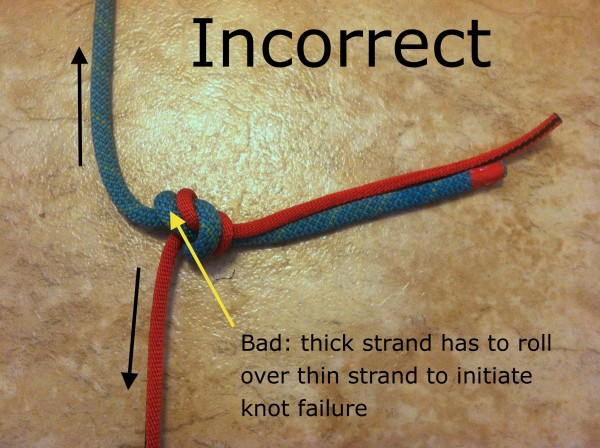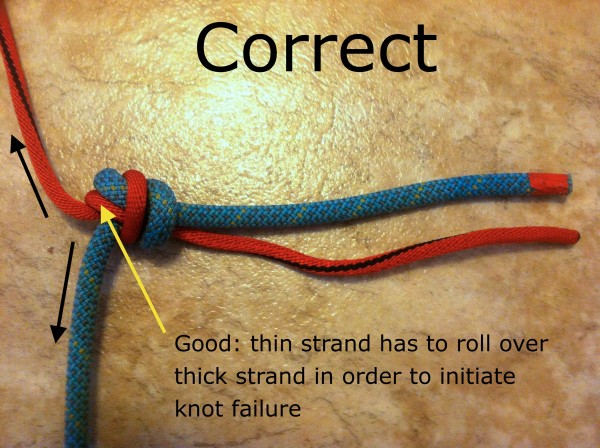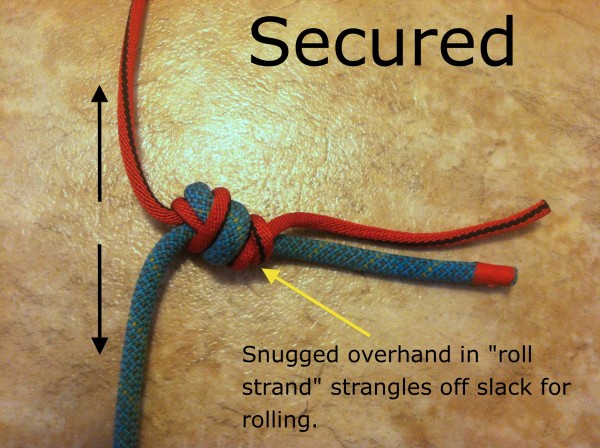Pull Cord/Tag Line Help
|
|
Looking for information on what size cord/what type to use for a pull cord full length rappelling setup. I currently have a 8 mil static ive been using as a tag line but its not packable into a backpack and doubles rope management issue, also its heavy.
Cheers, Jaysen |
|
|
If you've got the bucks, I'd consider the Edelrid Rap Line II. Read about the details at blog.weighmyrack.com/edelri…. |
|
|
A friend of mine had five mill. It was very hard and even painful to pull. I would not recommend it. I have a 62 m six mill that I don't really use and I would sell it for cheap if you are interested. I have only used it a handful of times. |
|
|
The thinner the cord, the faster it will wear out from abrasion, the more easily it will tangle, and the more likely it is to hang up on stuff when pulling. If the pull cord is too much thinner than the rap line, joining the ropes with an overhand knot (widely regarded as a really good way to join two ropes for rappelling) becomes less secure. For all these reasons, the law of diminishing returns seems to kick in somewhere around 7 mm, for me at any rate. |
|
|
Check out esprit alpine escape line or the above mentioned edelrid rap line |
|
|
mark felber wrote:The thinner the cord,...the more likely it is to hang up on stuff when pulling.You're pulling the tag line, so it isn't going to hang up on stuff the way a falling rope might. Of course, it might hang up when you toss it, but at least you are above the snags. Many people keep the tag line with them when rapping rather than throwing it. mark felber wrote:If the pull cord is too much thinner than the rap line, joining the ropes with an overhand knot (widely regarded as a really good way to join two ropes for rappelling) becomes less secure.Do you have pull test references for this? I think it likely that properly tied, the EDK is actually more secure with unequal diameter ropes, because you can minimize rolling, which is the primary failure mode. See for example Don't get me wrong, I think a thin tag line is a bad solution to the need for full-length rappels, unless you just want it for an occasional single rap. But At least with the Edelrid you can lead back up on it after your good line comes free of the anchor and then hangs up. But the OP wasn't asking for advice on this... |
|
|
Never rap on lines with large differences in diameter, the friction properties are different and can cause a variety of issues. The best way to rap with a pull cord is to "fix" the line in a closed loop with an alpine butterfly and a locker. This is what makes this method a "pull cord" and not a tagline. |
|
|
rgold wrote: You're pulling the tag line, so it isn't going to hang up on stuff the way a falling rope might.When doing a multi-rappel descent, it's very common to feed the rope being pulled into the anchor for the next rappel as the rope is being pulled, so that when the rope is clear of the rappel just completed it is set up for the next rappel. This saves time and effort, but it means that each rope is going to be the pull cord on half of the rappels on a given descent. |
|
|
If you feed the tag line during multipitch rappels, then you need to be super careful about uneven running of the ropes, and take one of several different measures---one mentioned above---to keep disaster at bay. You also have to be comfortable committing the entire rappel load to the tag line. |
|
|
I always rap both ropes and do alternate the lines feeding on multiple raps...the thing that hasn't been mentioned (I don't think) is a STATIC rap line is the only way to go |
|
|
I have used the Personal Escape by Esprit for over 10 years and have cut the original to 52 meters because of a core shot due to using it in Josh as the anchor on Hot Rocks. Should of protected the knot because of stretch in it causing it to rub a little too much during our repeated TR attempts. Usually thread the tag for really hard pulls with a lot of friction as the tag has less friction thru the anchor. |
|
|
Tried 5mm - hard to pull as someone said. Now am back to 6 mm. But get "static" cord, not dynamic. Makes a world of difference. |
|
|
The pictures do not signify a specific anchor location, the primary detail is whether the skinny or thick cord is on the inside or outside of the overhand knot. |
|
|
The photos are focused on how to join the ropes relative to the forces that will act on them. |
|
|
Hobo Greg wrote: The two previous comments ought to suffice, and Bill came close to pinning down the locale. There is no anchor in the picture, no implied anchor location, and yes, you usually rap on the thicker strand. |
|
|
Hobo Greg wrote: I treat it as a pretty serious step to do. This application of the knot is relatively weak by comparison to other knots / applications. Hence, a lot of detailed but still easy-to-do steps are advised (below) to minimize the chance of total failure. And proper orientation for dissimilar cord diameters is just one more easy and important step. Details ... Most complete instructions about tying the EDK include relatively long tails - 18 inches is what I've usually seen. The long tails allow for an initial capsize and then the usual tightening up - as opposed to the knot being able to simply and immediately roll off when the tails are too short. By 'tightening up', I mean that the force needed for the initial capsize can be surprisingly low, both by itself (!) and in comparison to the force subsequently needed to continue to total failure (see Tom Moyer's Page on EDK Testing). So, while long tails can make a difference between a) a scare-y partial failure and b) a gawd-awful total failure under relatively small loads, better is if one can avoid even partial failure. And steps can be taken to help avoid partial failure, such as:
3. Configure the knot to maximize the force needed to start the capsize (i.e., skinny cord must first roll over the fat one) … if one does not do #3, I suspect the dissimilar cord diameters actually reduces (!) the force needed to get to a scare-y partial failure as compared to like-diameter cords. |
|
|
Just get half ropes or twins. ;) |
|
|
A habit left over from the early days of EDK use, I always use the "secured" version (third pic) of the EDK, even when rope diameters are the same. The extra single knot adds very little bulk, unlike some recommendations to just tie two overhands one on top of the other. |
|
|
User76 wrote: Thanks Mr. gold I actually never knew some of the history of the flemish bend. However I actually did mean tie the first eight on a bight. Then tie the second rope to the bight as if you were tying in to your harness.The first eight for a harness tie in is usually not done “on a bight” of rope. To be a bit clearer, the harness tie in at the rope end is often called a “figure eight rewoven.”. While a “figure eight on a bight” looks identical in how the rope runs through the knot but can be easily tied at any point along the length of the rope, even in the middle. (Sorry no can do pics right now.) |
|
|
User76 wrote: ...I actually did mean tie the first eight on a bight. Then tie the second rope to the bight as if you were tying in to your harness. I honestly can't imagine why anyone would do this with rappel ropes. Is it possible you don't know what "bight" means? You are saying that you tie this: In one end and then follow it through with the other end. The knot part would have altogether three parallel stands and a loop sticking out to catch on everything when you pull the rappel. |
|
|
Oh, linked figure-eights on bights. Don't do it unless there is a tremendous difference in rope diameters, as it'll get hung up everywhere. |

 Continue with onX Maps
Continue with onX Maps Continue with Facebook
Continue with Facebook


























